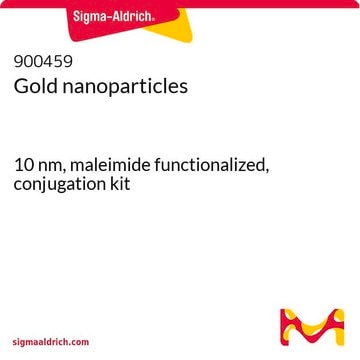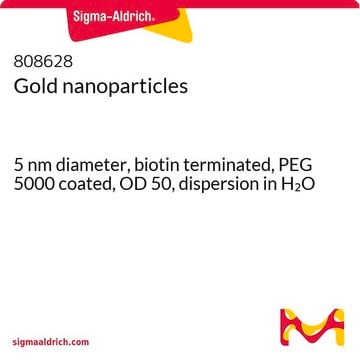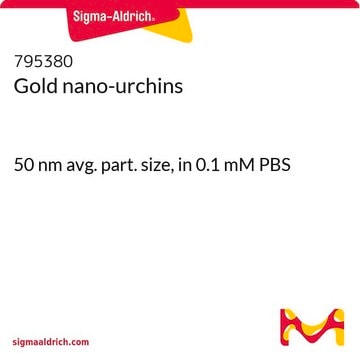The weight concentration is 6.07E-02 mg/mL. The product is tannic acid stabilized, indicating that tannic acid is present on the surface of the gold nanoparticles. While citrate is typically used on larger particles, tannic acid is used at this size. This should not pose a problem for various applications, as the tannic acid can be easily displaced by proteins, ligands, etc. The suspension is in 0.1 mM PBS.
752584
Gold nanoparticles
10 nm diameter, OD 1, stabilized suspension in 0.1 mM PBS, reactant free
Synonym(s):
Au NP, Gold colloid
Select a Size
About This Item
Recommended Products
Quality Level
form
nanoparticles
suspension
concentration
~6.0E+12 particles/mL
OD
1
diameter
10 nm
λmax
515-519 nm
storage temp.
2-8°C
SMILES string
[Au]
InChI
1S/Au
InChI key
PCHJSUWPFVWCPO-UHFFFAOYSA-N
Looking for similar products? Visit Product Comparison Guide
General description
Application
- Development of a biophotonic fiber sensor using direct-taper and anti-taper techniques with seven-core and four-core fiber for the detection of doxorubicin in cancer treatment.: Gold nanoparticles play a crucial role in enhancing the sensitivity and precision of fiber optic sensors for detecting chemotherapy drugs, demonstrating their significant potential in medical diagnostics and pharmaceutical research (Li et al., 2024).
- Generalized ratiometric surface-enhanced Raman scattering biosensor for okadaic acid in food based on Au-triggered signal amplification.: Gold nanoparticles are utilized to amplify Raman scattering signals, improving the detection of toxins in food products, which is essential for food safety and public health research (Wei et al., 2024).
Legal Information
Storage Class
12 - Non Combustible Liquids
wgk_germany
nwg
flash_point_f
Not applicable
flash_point_c
Not applicable
Choose from one of the most recent versions:
Already Own This Product?
Find documentation for the products that you have recently purchased in the Document Library.
Customers Also Viewed
Articles
Steven J. Oldenburg, Ph.D. provides an overview of lateral flow diagnostic assays and discusses the use of ultra-bright reporter particles based on the unique optical properties of gold nanoshells that significantly increase the sensitivity of lateral flow immunoassays.
Sustainable energy sources with high production efficiency are crucial for meeting increasing energy demand.
Gold (Au) nanoparticles have tunable optical and electronic properties and are used in a number of applications including photovoltaics, sensors, drug delivery & catalysis.
Recent research highlights tunable properties of inorganic nanoparticles, driving interest in optoelectronics.
-
What is the weight percentage of the gold nanoparticles? Any there any other components besides gold nanoparticles?
1 answer-
Helpful?
-
-
Gold nanoparticles is reactant free, what does this mean?
1 answer-
Cytodiagnostics Reactant Free Gold Nanoparticles are supplied in 0.1mM phosphate buffered saline (PBS) and are extensively purified to eliminate residual reactants from manufacturing, making them suitable for sensitive applications such as cell work and nanotoxicology studies.
Helpful?
-
-
New to gold nanoparticles. How is the gold nanoparticles stabilised? Are they functionalised with citrate? Is there a surface charge on them (if so what is it positive or negative?)
1 answer-
According to the manufacturer, these gold nanoparticles are stabilized by tannic acid. They are not functionalized with citrate. The surface charge of these gold nanoparticles is not determined. See the link below to the manufacturers product page:
https://www.cytodiagnostics.com/collections/reactant-free-gold-nanoparticles/products/10nm-reactant-free-gold-nanoparticles?variant=31523912810570Helpful?
-
-
Which gold nanoparticle size should I choose for my application?
1 answer-
The size of gold nanoparticle to use is very depandent upon the intended application. Generally, smaller particles offer better sensitivity in applications such as immunogold labeling due to less steric hindrance and the ability to bind more gold nanoparticles to the desired target. Small gold nanoparticles are less visible than larger particles, however, which must also be taken into account.As an application example, particles with a size between 30-50nm are particularly useful for the development of rapid tests such as lateral flow assays.
Helpful?
-
-
How do you attach gold nanoparticles to peptides and peptide conjugates?
1 answer-
To view information on how to attach gold nanoparticles to peptides and peptide conjugates, please view the information in the reference - Rosenthal, S. J. and Wright, D. W. (Eds.). (2005), p. 91-92. NanoBiotechnology Protocols. New Jersey. Humana Press.
Helpful?
-
-
What is the shape of the gold nanoparticles?
1 answer-
The majority (>95%) of the gold nanoparticles are spherical.
Helpful?
-
-
How do you attach gold nanoparticles to oligos?
1 answer-
To attach gold nanoparticles to oligos please view the information in the attached reference - Bioconjug Chem. 2011 Apr 20;22(4):794-807. Epub 2011 Mar 28.
Helpful?
-
-
Can the Gold nanoparticles be frozen?
1 answer-
No, the Gold nanoparticles should not be frozen. If frozen, the gold nanoparticles will irreversibly aggregate, turning the solution clear.
Helpful?
-
-
How do you attach gold nanoparticles to glass?
1 answer-
To view the procedure on how to attach gold nanoparticles to glass please view information in the reference - Journal of Atomic, Molecular, and Optical PhysicsVolume 2012 (2012). Article ID 683830, 6 pagesdoi:10.1155/2012/683830
Helpful?
-
-
How does the storage temperature relate to shipping conditions?
1 answer-
The storage conditions that a Sigma-Aldrich catalog and label recommend for products are deliberately conservative. For many products, long-term storage at low temperatures will increase the time during which they are expected to remain in specification and therefore are labeled accordingly. Where short-term storage, shipping time frame, or exposure to conditions other than those recommended for long-term storage will not affect product quality, Sigma-Aldrich will ship at ambient temperature. The products sensitive to short-term exposure to conditions other than their recommended long-term storage are shipped on wet or dry ice. Ambient temperature shipping helps to control shipping costs for our customers. At any time, our customers can request wet- or dry-ice shipment, but the special handling is at customer expense if our product history indicates that the product is stable for regular shipment.
Helpful?
-
Active Filters
Our team of scientists has experience in all areas of research including Life Science, Material Science, Chemical Synthesis, Chromatography, Analytical and many others.
Contact Technical Service




